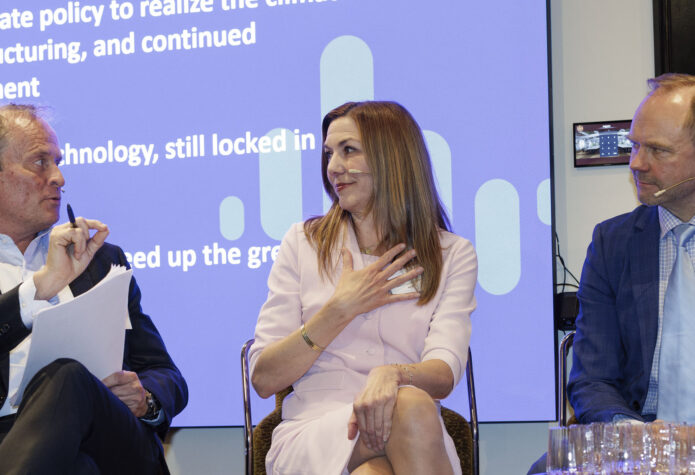Towards Norway 2050: Exploring the green renewal

On 23 April, NIB and its Board of Directors hosted a seminar in Oslo for the Bank’s clients, investors, peers and other stakeholders on Norway’s green transition to a low-emission society by 2050. Including updates from Erlend Trygve Grimstad, State Secretary in Norway’s Ministry of Finance, on Norway’s economy, investments and the green transition, and NIB President and CEO André Küüsvek’s presentation on the Bank’s role in financing this transition, the seminar provided nuanced views on overcoming barriers to decarbonising hard-to-abate sectors like maritime transport while fostering innovation and digitalisation. Thina Margrethe Saltvedt, Chief Analyst of Sustainable Finance at Nordea, spoke of the challenges to Norway’s green transition and the need to end oil and gas sector path dependency.
Grimstad said Norway’s economy had managed well during the covid pandemic and ongoing geopolitical tensions, with the economy showing signs of a soft landing. Inflation, which peaked at 7.5% last year, was forecast to stabilise at about 3.9% this year and fall to 2.5% next year.
Unemployment remained exceptionally low at 1.9%, with minimal expected increases. Economic growth continued, and Grimstad was overall cautiously optimistic and expected inflation to be managed effectively without severe impacts on employment or the real estate market.
Speaking about investment in Norway’s mainland industries, Grimstad said it was currently at its highest since records began in 1970, exceeding the 2013–2021 average by more than 40%. He said this indicated strong confidence in future returns and significant engagement with the green transition.
“Of course, we’re still a country with a significant oil and gas sector which is an extremely important contributor to the economy. However, the Norwegian Offshore Directorate expects production to decrease quite significantly from 2030. Naturally, this will be a big challenge. If these assessments are correct, production will decrease by 60% by 2050,” said Grimstad.
Grimstad also spoke about the government’s approach to facilitating the green transition. The primary tool was carbon pricing, with approximately 85% of emissions currently priced via ETS (Emissions Trading System) or CO2 taxation. The government was supporting these efforts with subsidies and fiscal tools, addressing market failures and enhancing initiatives like those of Enova, a government enterprise responsible for promoting environmentally friendly production and energy consumption, which involved substantial investment in technologies like carbon capture and storage and electric vehicle subsidies.
Norway aims to become a low-emission society by 2050, targeting a 90–95% cut in greenhouse gas emissions from 1990 levels. In supporting this goal, the government is seeking a 55% reduction by 2030. Since 1990, while CO2 emissions have increased, other greenhouse gas reductions have resulted in a total emission decrease of 4.6%. Oil and gas extraction, industry, and transport are the main emission sources.
Grimstad emphasised the importance of these measures for ensuring effective long-term investment decisions crucial for the transition from a petroleum-based economy, which, for all its past benefits, was seen as unsustainable.
“The IFIs and development banks, both in Norway and internationally, play a wider role. I think NIB has successfully established its role in the Nordics.”
NIB’s role in financing the future
During the seminar, Küüsvek shared insights concerning NIB’s role and long-term lending in Norway, presenting the Bank’s mandate to improve productivity and benefit the environment.
“We cannot let short-term economic considerations distract us from the long-term goal of a sustainable future. The green transition is a major challenge, but it is also an opportunity. By investing in clean technologies, we can create jobs, boost economic growth, and protect the environment. We should not let short-term issues take the commitment away from the long-term transition targets,” Küüsvek said.
Norway struggles with path dependency
Saltvedt highlighted Norway’s difficulty in meeting its ambitious climate goals, stressing the need for increased investment and the urgency of achieving the 2030 targets. Saltvedt said that despite setting ambitious goals, Norway was clearly struggling with ongoing dependence on the oil and gas sector, clearly conflicting with its green ambitions.
“We really must accelerate if we’re going to make the investments needed for 2030. So what are the challenges? We have ambitious goals, but our strategies and policies haven’t really been sufficiently ambitious to bridge them,” said Saltvedt.
Saltvedt underlined the need for a clear and unified national policy and strategy to effectively transition to a green economy, reducing reliance on fossil fuels and aligning more closely with EU directives, which aim for significant emissions reductions by 2040.
“We need to escape from oil and gas sector path dependency if we’re to break through and make the green transition,” Saltvedt said.
NIB has operated in Norway since 1977. The Bank has provided EUR 12.6 billion (NOK 147.5 billion) to fund more than 370 projects in the country. We finance projects that improve the productivity and benefit the environment of the Nordic and Baltic countries.
In recent years, NIB has financed electricity distribution and transmission networks, transport electrification, and renewable energy generation. NIB has also contributed to the development of hydropower and wind power projects.
In 2024, NIB signed the first InvestEU loan in Norway with the ferry company Norled AS. Looking ahead, NIB will continue to support and accelerate the green transition.